|

Volume 1 - April 2018
During the next two years, we, the U.S. Fish and Wildlife Service (Service), will develop comprehensive
conservation plans (CCP) for all the units of the National Bison Range Complex
(Complex). We will develop a CCP and
environmental impact statement (EIS) for the National Bison Range and
concurrently develop a CCP and environmental assessment for Lost Trail National
Wildlife Refuge (NWR), Pablo NWR, Ninepipe NWR, and the Lake County and
Flathead County Wetland Management Districts (WMD).
A wetland management district
(WMD) is composed of and provides oversight to waterfowl production areas
purchased with Duck Stamp funds, as well as wetland and grassland conservation
easements within an approved boundary. These lands are part of the National Wildlife Refuge System (Refuge System), a
network of lands set aside
to conserve fish and wildlife and their habitat.
In 1997, Congress passed the
National Wildlife Refuge System Improvement Act (Improvement Act). This legislation provides clear guidance to manage all the
units of the Refuge System.
The Improvement Act directs
the Service to manage the Refuge System
as a national system of lands and waters devoted to the conservation of wildlife and maintenance of the
biological integrity of ecosystems.
The Improvement Act also requires us
to develop a CCP for each unit in the Refuge System. CCPs provide long-range
guidance and management direction
for all the programs of the units of the Refuge System. CCPs are “living” documents that are updated every 15 years.
As required by the National
Environmental Policy Act (NEPA), the CCPs and the accompanying NEPA documents
we are developing for the Complex will describe
a range of viable management alternatives being
considered and their effects
on the environment.
In summary, the CCPs will:
- Outline
a vision.
- Guide management decisions.
- Outline goals,
objectives, and strategies to achieve
the purposes of all units of the Complex.
- Provide local and
tribal governments, other agencies and the public with an understanding of the management actions to be carried out across the Complex.
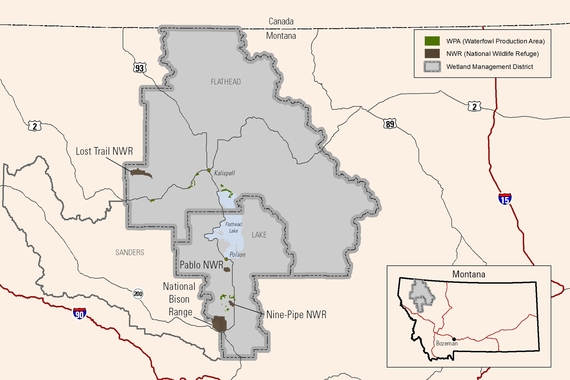 A map of the National Bison Range Complex in Montana by USFWS
This planning update is being
widely distributed to generate further interest in the planning
process, inform the public of status of the plan, and collect ideas
and thoughts from the public, tribal, state
and local governments, organizations, and other partners.
You may unsubscribe from this electronic newsletter at any time and can check the CCP planning website for updates: https://www.fws.gov/mountain-prairie/refuges/nbrc.php
May 2017
- Notice of Intent in Federal Register
- Gather public input
June – November 2017
- Meet with cooperating
agencies and form a Planning Team
- Develop vision and a set of goals
March 2018
- Develop management
alternatives
May 2018
Summer – Winter 2018
- Prepare draft plans and
NEPA analysis
March 2019
- Publish a Notice of
Availability in the Federal Register and release the draft plans and NEPA
analysis for public review
Summer 2019
March 2020
- Complete
final plans and environmental compliance documents
Public Involvement and Scoping
We are pleased to announce the release of a draft vision, a draft set of goals, and a draft range of management alternatives for the CCPs for all the units of the National Bison Range Complex for public review and comment. We are seeking the input of the public, our conservation partners, and tribal, state, and local governments. During this public comment period, we invite you to provide us your comments and to attend any of the four public meetings that the Planning Team will hold to welcome your comments and answer your questions in person.
If unable to attend any of these meetings, you may provide your comments in writing via postal service or email at one of the addresses listed under the “Contacts” section below. We will evaluate all comments received during this public comment period and all substantial comments will be used to improve the draft vision, goals, and alternatives prior to the development of the draft CCPs and their NEPA documents.
Draft Alternatives Public Meetings
We will host two evening open-house public meetings that will include brief presentations at 6:00 p.m. on the planning process and on draft documents for which we are seeking comments.
Date: May 9, 2018
Time: 5:00 p.m. - 8:00 p.m.
Location: Montana Fish, Wildlife and Parks Office
Address: 490 N. Meridian Rd., Kalispell, MT 59901
Venue Phone: (406) 752-5501
Date: May 10, 2018
Time: 5:00 p.m. - 8:00 p.m.
Location: Leon Hall
Address: 984 Leon Road, Charlo, MT 59824 (NE corner of Leon Road and Kerns Road)
Venue Phone: (406) 644-2145
In addition to these evening open-house meetings, we will also host all-day, open-house events at the headquarters of the National Bison Range and of the Lost Trail NWR. We invite the public to stop by the these refuges at any time during normal business hours to meet with members of the Planning Team, learn more about the units of the Complex, about the planning process, and provide your input.
Date: May 11, 2018
Time: 8:00 a.m. - 4:00 p.m.
Location: National Bison Range Headquarters
Address: 58355 Bison Range Rd., Charlo, MT 59824
Venue Phone: (406) 644-2211
Date: May 8, 2018
Time: 8:00 a.m. - 4:00 p.m.
Location: Lost Trail Refuge Headquarters
Address: 6295 Pleasant Valley Rd., Marion, Montana 59925
Venue Phone: (406) 858-2216
---
Four public scoping sessions were also held in the summer of 2017 in nearby
communities, including Kalispell, Missoula, and Polson, MT.
During these meetings, the Service
informed participants about the planning process, answered questions, and
received comments from interested members of the public.
Additionally, many comments were submitted in
writing in response to the Notice of Intent published in the Federal
Register. These comments are public
record and have been made available on the project website. To view the public comments received, visit https://www.fws.gov/mountain-prairie/refuges/nbrc.php and click the documents tab toward the bottom of the web
page. There will be a link to a PDF file
named NBRC Public Scoping Comments.
- Subscribe to this e-newsletter
- Visit the planning website for information
- Look for announcements in the media
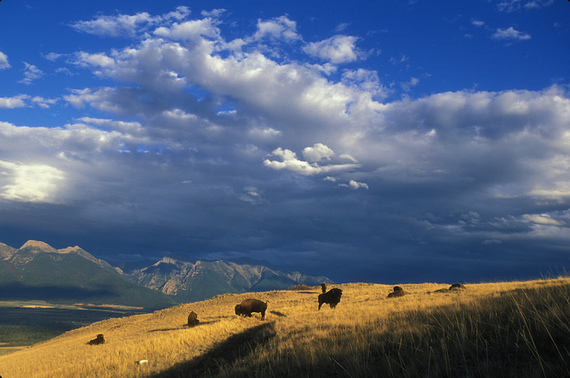 Bison at National Bison Range by Ryan Hagerty/USFWS
The Planning Team for the
CCPs of the Complex includes members of the Complex staff and the U. S. Fish
and Wildlife Service Region 6 Regional Office, the Bureau of Indian Affairs,
the Confederated Salish and Kootenai Tribes, Lake County, Sanders County, and Montana
Department of Fish, Wildlife and Parks. During
November 2017, the planning team developed a draft vision and a set of goals
based primarily on the mission of the Refuge System and legislative purposes of each unit of the Complex. During
the public review process we ask the public to review the
vision, goals, and draft alternatives that the Planning Team has developed and
provide us with input and comments.
Draft Vision
“Relax and take a deep breath
while you step back in time to reflect on what was, what is and what is yet to
come. Immerse yourself in the inter-montane valleys of northwestern Montana
shaped by glacial forces and steeped in rich cultural history. This is a special landscape important to
people age after age, where we pay tribute to the persons and peoples who set
aside the lands, conserved the wildlife and plants, and were stewards of
various components that make up the Complex. Visitors from all over the world travel to the Complex which seeks to
provide an opportunity to learn and experience varied habitats, abundant
wildlife and the natural beauty of these lands. The units of the Complex safeguard these values and preserve
connectivity across the landscape, forming continuity through time for future
generations to treasure. Each unit is
unique, and collectively they have, and will continue, to contribute to the Complex
and the Refuge System. Partners foster
cultural and natural resources conservation where the cultural history is
expressed across the landscape. Unique
opportunities to work with partners benefit many of the units within the
Flathead Indian Reservation and other units located within traditional
homelands of the Salish, Upper Pend d’Oreille, and Kootenai Tribes.”
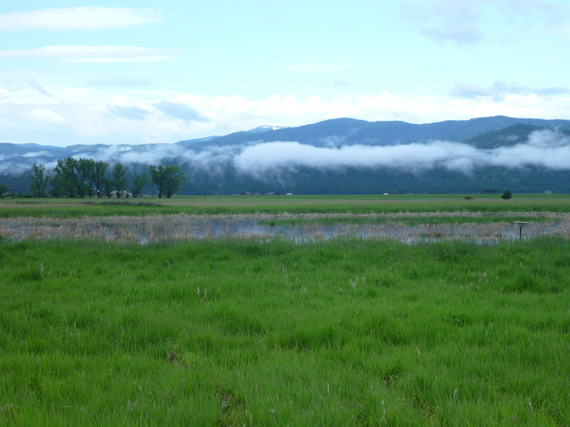 Blasdel Waterfowl Production Area (WPA) in the Northwest Montana Flathead County Wetland Management District in Montana by USFWS
Draft Goals
-
Cultural Resources: Preserve and value the cultural
resources and history of the National Bison Range Complex to connect staff,
visitors, and community to the area’s past and continuing traditions.
-
Partnerships
and Collaboration: Maintain and cultivate partnerships that help
achieve the vision and supporting goals and objectives of the National Bison
Range Complex to support wildlife and habitat conservation, research, foster
awareness and appreciation of natural and cultural resources, and provide
education along with all necessary infrastructure of the inter-montane
ecosystem of western Montana. Recognizing its importance, we will collaborate with the Confederated
Salish and Kootenai Tribes and other Tribal governments in a manner consistent
with the Service’s Native American policy and with other Federal, State,
and local government entities in a manner consistent with applicable Service
policies.
-
Public Use: Provide compatible,
wildlife-dependent recreational opportunities, for persons of all abilities, to
learn, enjoy, and appreciate the inter-montane landscape of western Montana,
the fish and wildlife and plants.
-
Wildlife Management: Protect, maintain, and restore
healthy and diverse wildlife populations with respect to species that are
endemic, migratory, and mandated species of concern.
-
Invasive Species: Prevent, reduce, and contain the
invasion and spread of noxious, invasive, and harmful nonnative species within
the Complex while working with partners to address off-Complex infestations
within the surrounding landscape.
-
Habitat Management: Conserve, restore, and promote
biological integrity in functional and sustainable ecologically diverse
habitats of the inter-montane ecosystem of western Montana.
-
Research and Science: Encourage high quality research
and promote the use of scientifically sound management decisions.
-
Administration and Operations: Effectively use funding, staff,
partnerships, volunteers, and equipment to restore and manage Complex habitats,
conduct programs, and improve and maintain all necessary infrastructures to the
benefit of the Complex and the Refuge System.
-
Monitoring and Adaptive
Management: Through the
life of this plan, we will monitor and evaluate the consequences of our actions
and use adaptive management to reach desired outcomes.
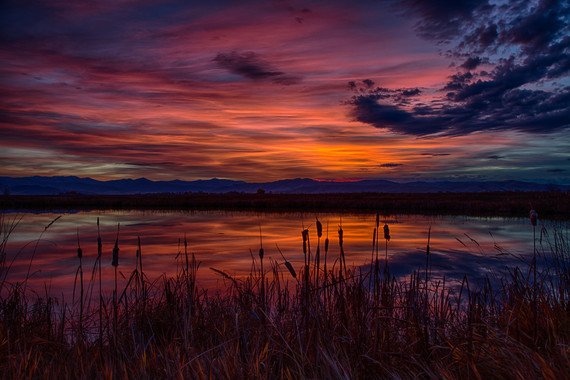 Ninepipe National Wildlife Refuge in Montana
Draft
Alternatives for Future Management
The Planning Team has
developed a draft set of management alternatives for the Complex.
The following are short
descriptions of each alternative:
Alternative A: No Action
Under this alternative we would continue all the current
management activities, and maintain funding, infrastructure, all programs, and
staffing at existing levels.
Alternative B: Maximize the Quality of Public Experiences
This alternative emphasizes managing habitat and wildlife populations
to provide quality,
wildlife-dependent opportunities for the public. All programs of
the Complex would foster
public support and appreciation for the resources of our land
and our waters. The Service would
maximize these recreational opportunities by providing improved
access, facilities, interpretive
materials, and environmental education. The Service would aim to
maintain natural processes
and healthy wildlife populations through partnerships to enhance
the quality of the public’s
experience.
Alternative C: Manage for Ecological Sustainability
This alternative emphasizes maintaining and/or enhancing
ecological communities, recognizing ever-changing environmental conditions. In cooperation with our partners,
the Service would use a prioritization framework to identify and define future
conditions that will drive management actions to:
- Build ecological community resiliency
- Promote species diversity
- Increase integrity of habitats
- Restore natural processes
Alternative D: Species-Focused Management
Under this alternative, carrying capacity for target species
would generally drive management of
wildlife and plant population numbers. Lands would be managed
under a corridor concept for
transient species populations (e.g. wolverine, lynx, grizzlies,
wolves). Carrying capacity for
bison would be determined in concert with carrying capacities
for other species. Bison
population management would also involve genetic diversity
considerations. Targeted species
populations (e.g. Spalding’s catchfly, trumpeter swans, and
bighorn sheep) would be managed
with individualized considerations (e.g. disease, threatened and
endangered species, and habitat).
Management objectives would include managing for a diversity of
species, including plant
species.
Alternative E: Collaborative/Partner-Based Landscape Level
Conservation
Units of the Complex are separated by significant distance
across the landscape. All are part of
the Northwestern
Montana ecosystem. To provide connectivity with the larger landscape and
preserve unique components of each small unit, this alternative
seeks to facilitate collaborative,
cooperative, and coordinated management of the Complex with our
federal, tribal, state, local,
public, and private partners. This alternative seeks to increase
opportunities for public use and
education. It seeks to provide better opportunities for fish,
plant, and wildlife habitat on lands
outside the boundaries of our units by creating corridors for
habitats, conducive to wildlife
migration and movement. It also seeks to incorporate the
expertise, resources, and efforts of our
partners to help facilitate the benefits of a broader
functioning landscape. This approach
promotes the shared responsibility of managing actions across
the landscape.
The Service is seeking input from the public on these draft
alternatives. Please check the CCP website as well as look for announcements in
the local media for information on upcoming public meetings. Comments and
questions can also be submitted via:
Scoping_nbr@fws.gov (for comments
on the National Bison Range)
and
Scoping_pablo_ninepipe@fws.gov (for comments
on Ninepipe, Pablo, and Lost Trail National Wildlife Refuges, and the Flathead and Lake County
Wetland Management Districts)
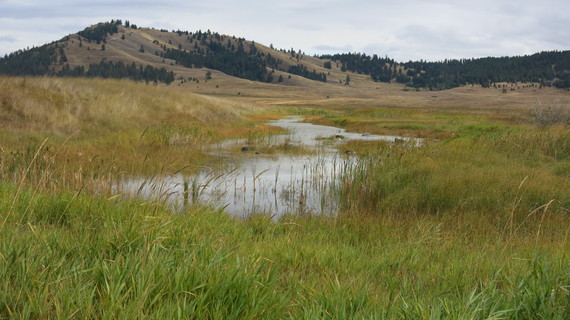 Batavia Batavia Waterfowl Production Area (WPA) in the Northwest Montana Flathead County Wetland Management District in Montana by USFWS
Contact Information
Contacts
Bernardo Garza and Vanessa Fields, Planning
Team Leaders
U.S. Fish and Wildlife Service
Division of Refuge Planning
P.O. Box 25486
Denver, CO 80225-0486
Email: bernardo_garza@fws.gov or
vanessa_fields@fws.gov
Phone: (Bernardo) 303-236 4377; (Vanessa) 406-217 6473
Fax: 303-236-4792
National Bison Range
Refuge Complex Comprehensive Conservation Plan
Address: 58355
Bison Range Rd, Charlo, MT 59824
Phone: 406 -644-2211
Fax: 406-644-2661
|